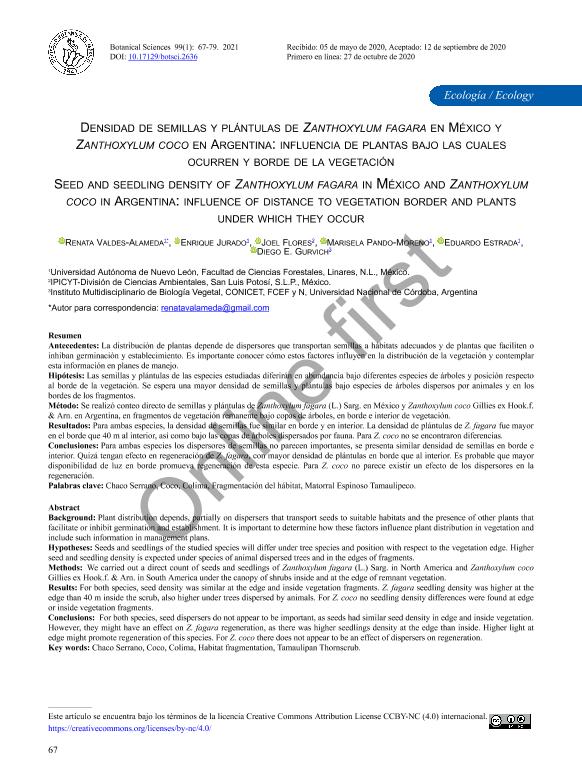Mostrar el registro sencillo del ítem
dc.contributor.author
Valdes Alameda, Renata
dc.contributor.author
Jurado, Enrique
dc.contributor.author
Flores, Joel
dc.contributor.author
Pando Moreno, Marisela
dc.contributor.author
Estrada, Eduardo
dc.contributor.author
Gurvich, Diego Ezequiel

dc.date.available
2021-07-13T22:07:11Z
dc.date.issued
2021-03
dc.identifier.citation
Valdes Alameda, Renata; Jurado, Enrique; Flores, Joel; Pando Moreno, Marisela; Estrada, Eduardo; et al.; Densidad de semillas y plántulas de Zanthoxylum fagara en México y Zanthoxylum coco en Argentina: Influencia de plantas bajo las cuales ocurren y borde de la vegetación; Sociedad Botanica de Mexico, A.C; Botanical Sciences; 99; 1; 3-2021; 67-79
dc.identifier.uri
http://hdl.handle.net/11336/136025
dc.description.abstract
La distribución de plantas depende de dispersores que transportan semillas a hábitats adecuados y de plantas que faciliten o inhiban germinación y establecimiento. Es importante conocer cómo estos factores influyen en la distribución de la vegetación y contemplar esta información en planes de manejo.Las semillas y plántulas de las especies estudiadas diferirán en abundancia bajo diferentes especies de árboles y posición respecto al borde de la vegetación. Se espera una mayor densidad de semillas y plántulas bajo especies de árboles dispersos por animales y en los bordes de los fragmentos.Se realizó conteo directo de semillas y plántulas de Zanthoxylum fagara (L.) Sarg. en México y Zanthoxylum coco Gillies ex Hook.f.& Arn. en Argentina, en fragmentos de vegetación remanente bajo copas de árboles, en borde e interior de vegetación.Para ambas especies, la densidad de semillas fue similar en borde y en interior. La densidad de plántulas de Z. fagara fue mayor en el borde que 40 m al interior, así como bajo las copas de árboles dispersados por fauna. Para Z. coco no se encontraron diferencias.Para ambas especies los dispersores de semillas no parecen importantes, se presenta similar densidad de semillas en borde e interior. Quizá tengan efecto en regeneración de Z. fagara, con mayor densidad de plántulas en borde que al interior. Es probable que mayor disponibilidad
dc.description.abstract
Plant distribution depends, partially on dispersers that transport seeds to suitable habitats and the presence of other plants that facilitate or inhibit germination and establishment. It is important to determine how these factors influence plant distribution in vegetation and include such information in management plans. Hypotheses: Seeds and seedlings of the studied species will differ under tree species and position with respect to the vegetation edge. Higher seed and seedling density is expected under species of animal dispersed trees and in the edges of fragments. Methods: We carried out a direct count of seeds and seedlings of Zanthoxylum fagara (L.) Sarg. in North America and Zanthoxylum coco Gillies ex Hook.f. & Arn. in South America under the canopy of shrubs inside and at the edge of remnant vegetation. Results: For both species, seed density was similar at the edge and inside vegetation fragments. Z. fagara seedling density was higher at the edge than 40 m inside the scrub, also higher under trees dispersed by animals. For Z. coco no seedling density differences were found at edge or inside vegetation fragments. Conclusions: For both species, seed dispersers do not appear to be important, as seeds had similar seed density in edge and inside vegetation. However, they might have an effect on Z. fagara regeneration, as there was higher seedlings density at the edge than inside. Higher light at edge might promote regeneration of this species. For Z. coco there does not appear to be an effect of dispersers on regeneration.
dc.format
application/pdf
dc.language.iso
spa
dc.publisher
Sociedad Botanica de Mexico, A.C
dc.rights
info:eu-repo/semantics/openAccess
dc.rights.uri
https://creativecommons.org/licenses/by-nc-sa/2.5/ar/
dc.subject
CHACO SERRANO
dc.subject
COCO
dc.subject
COLIMA
dc.subject
HABITAT FRAGMENTATION
dc.subject
TAMAULIPAN THORNSCRUB
dc.subject.classification
Ecología

dc.subject.classification
Ciencias Biológicas

dc.subject.classification
CIENCIAS NATURALES Y EXACTAS

dc.title
Densidad de semillas y plántulas de Zanthoxylum fagara en México y Zanthoxylum coco en Argentina: Influencia de plantas bajo las cuales ocurren y borde de la vegetación
dc.title
Seed and seedling density of Zanthoxylum fagara in México and Zanthoxylum coco in Argentina: Influence of distance to vegetation border and plants under which they occur
dc.type
info:eu-repo/semantics/article
dc.type
info:ar-repo/semantics/artículo
dc.type
info:eu-repo/semantics/publishedVersion
dc.date.updated
2021-07-12T13:16:52Z
dc.identifier.eissn
2007-4476
dc.journal.volume
99
dc.journal.number
1
dc.journal.pagination
67-79
dc.journal.pais
México

dc.journal.ciudad
Ciudad de México
dc.description.fil
Fil: Valdes Alameda, Renata. Universidad Autonoma de Nuevo Leon.; México
dc.description.fil
Fil: Jurado, Enrique. Universidad Autonoma de Nuevo Leon.; México
dc.description.fil
Fil: Flores, Joel. Instituto Potosino de Investigación Científica y Tecnológica; México
dc.description.fil
Fil: Pando Moreno, Marisela. Universidad Autonoma de Nuevo Leon.; México
dc.description.fil
Fil: Estrada, Eduardo. Universidad Autonoma de Nuevo Leon.; México
dc.description.fil
Fil: Gurvich, Diego Ezequiel. Consejo Nacional de Investigaciones Científicas y Técnicas. Centro Científico Tecnológico Conicet - Córdoba. Instituto Multidisciplinario de Biología Vegetal. Universidad Nacional de Córdoba. Facultad de Ciencias Exactas Físicas y Naturales. Instituto Multidisciplinario de Biología Vegetal; Argentina
dc.journal.title
Botanical Sciences
dc.relation.alternativeid
info:eu-repo/semantics/altIdentifier/doi/http://dx.doi.org/10.17129/botsci.2636
dc.relation.alternativeid
info:eu-repo/semantics/altIdentifier/url/https://botanicalsciences.com.mx/index.php/botanicalSciences/article/view/2636
Archivos asociados
